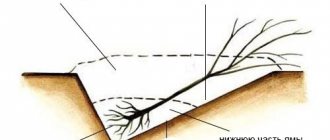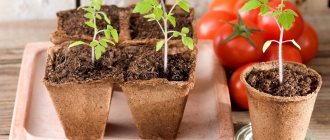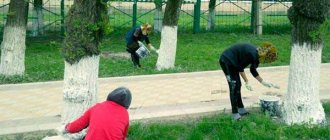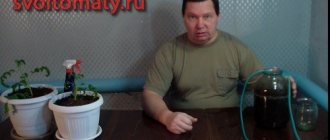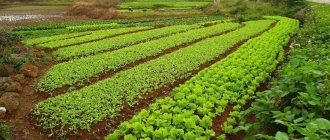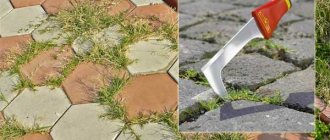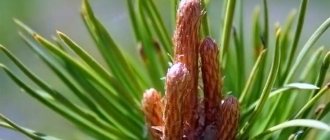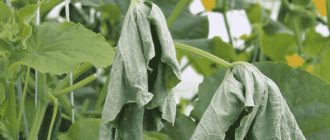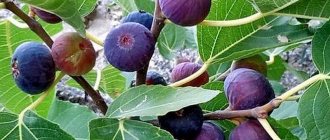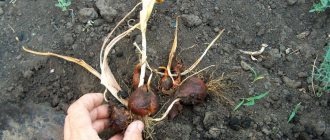Loading…
Loading…
Every season, dense thickets appear next to the cherry, plum, bird cherry and maple trees. In order for the garden to always look at the highest level, it is important to know how to remove tree growth on the territory of a country house. After all, the plants left behind will quickly turn the area into a local “jungle.” In addition, the yield of fruit crops is lost, which upsets true farmers. So, let’s find out what experts advise inexperienced gardeners. The main thing is to record these tips in your notebook.
Reasons for the formation of young shoots
Young “shoots” often form next to fruit crops that have suffered from various factors.
This can happen due to temperature changes, old age, or lack of microelements. However, growth around the tree also forms for other reasons:
- open root collar;
- damage to the cortex;
- many branches removed during pruning;
- wounds received mechanically.
In addition, there are cases when incompatibility between the rootstock and scion occurs. As a result, metabolic processes inside the plant are disrupted. Over time, the fruit crop loses its vitality, so it produces young shoots. As you can see, the cause of the problem is hidden in violation of the rules of care.
If the shoots are planned to be used for propagation, they are left at a distance of 2-4 m from the mother crop.
Chemical removal of tree growth from a site
To solve the problem, gardeners use 2 main methods: using chemicals and destroying the “shoots” mechanically. The first option is resorted to if the garden has turned into a dense and impenetrable “jungle”. But only as a last resort, so as not to harm other plants.
Suitable medications for the procedure:
- Roundall;
- Glukor;
- Tornado;
- Agrokiller.
However, before using chemicals, you need to figure out how to destroy the growth on the site in the most gentle way. For example, if an old tree is constantly sprouting, it is first cut down at ground level. Then, using a conventional drill, 5-7 holes with a diameter of 2 cm are made in the stump. They are placed away from the center of the cut so that the chemical gets into the root system. The procedure is repeated 2 more times, for 14 days.
To remove shoots, trees are injected using special syringes. The chemical is injected directly into the wood of the young shoot.
Gardeners often simplify the procedure. They make deep cuts on the trunk and branches. And then, the plant is irrigated abundantly with the drug. Spraying tree leaves with pesticides, amine salt 2,4-D, crotiline or butyl ether helps to get rid of unwanted “greenery”.
It is advisable to cover the holes with plastic or polyethylene. Thanks to this, the substance will fulfill its important mission.
Mechanical method of combating shoots
The easiest way to get rid of tree growth is with skillful hands, an axe, a shovel, a saw and a lopper.
Usually the procedure is performed in early spring according to this scheme:
- first determine the place where they are connected to the mother tree;
- the young sprout is carefully removed along with the root system;
- clean the area thoroughly.
In addition, after harvesting, fallen fruits are carefully collected. Otherwise, the seeds or seeds may eventually turn into young trees. Next, we’ll find out how to deal with plum and cherry growth throughout the season.
When removing young shoots, it is advisable not to damage the roots of the mother fruit crop.
Should I delete it?
Quite often the shoots are used for propagation. This is due to low labor and time costs. If you don’t bother yourself with special care for your garden, then after 2-3 years you can see the appearance of small trees. Crops such as cherries and plums are capable of forming fairly strong shoots.
It is worth noting that the use of such shoots is advisable only from own-rooted varieties. The fact is that such trees differ from grafted ones. If a plum or cherry has been grafted previously, then their shoots will have other external characteristics: color, size of leaves and buds.
Before taking a seedling, make sure that the plant is completely healthy and bears fruit well.
Digging of seedlings occurs in September or early spring.
Two-year-old plants whose root system has already become stronger are ideal for this role. They usually grow at a distance of 2-3 meters from the tree. You should dig carefully so as not to damage the roots.
Using shoots for propagation may seem like a good and economical option. But that's not true. Often trees that are grown with the help of such shoots do not have such a bountiful harvest.
Intentional cultivation of shoots harms the mother tree, it begins to weaken, and the amount of harvest decreases. After all, the formation of shoots already indicates the poor condition of the tree. Therefore, it is better to get rid of the appearance of overgrowth.
Plum shoots
As you know, plum trees tend to produce thick shoots regardless of age. It appears in both young and old trees. In addition, almost all varieties of plums produce young shoots. The main cause of the problem is deep loosening of the tree trunk area. It turns out that the plum root system is very sensitive to such a procedure. Once you touch it with a shovel, it immediately produces new shoots. Over time, they take root and turn the garden into dense, chaotic thickets.
Another reason for the formation of shoots is a serious disease of the fruit crop, which slowly kills it. Usually, the violent appearance of shoots indicates precisely this problem. In any case, the shoots are removed very carefully. At the same time, they try to capture the entire formed root system, at a very close distance from the mother root. The sprouts are cut using pruning shears and then covered with clay or garden varnish.
Cherry and its shoots
Gardeners have noticed that grafted crops of the “Shubinka” and “Vladimirskaya” varieties usually do not produce many young shoots. However, for others they grow quickly, taking up space in the garden.
Most often this applies to such varieties:
- Robin;
- Youth;
- Rastorguevskaya;
- Memory of Enikeev.
As a rule, the shoots of grafted crops usually grow into wild plants, the fruits of which have no particular value. Therefore, inexperienced summer residents should know how to permanently get rid of cherry shoots in their garden plot. There are several traditional methods.
Often, young shoots are removed using pruners or an ax. However, the procedure is done strictly according to the rules and very carefully. :
- start cutting out the shoots at the first appearance;
- cut down the root shoots in early spring or late autumn, removing the soil layer;
- the remaining cuts on the mother tree are generously treated with garden varnish;
- fill the place where the young shoot was removed.
By following the recommendations of experts, you can forever free your garden from uninvited “settlers”. If the shoots are simply cut down, after a year at least 3 shoots will appear in the same place.
Dense thickets are removed using herbicides:
- Zero;
- Glysol;
- Alaz;
- Roundal.
The drugs are diluted strictly according to the instructions specified by the manufacturer. Sometimes the procedure is repeated a year later if a relapse occurs.
After removing the growth, sheets of slate are dug into the root area, at a distance of 1.5 m. They deepen it by 1 m. If the sprouts appear again, they are immediately cut off with pruning shears so that they do not have time to take root.
Why is it necessary to destroy cherry shoots?
Every year, the cherry tree produces young shoots, sometimes at a fairly large distance from the mother trunk.
No matter how sorry you are for the trees, you should under no circumstances leave them. Firstly, they sprout in inappropriate places and spoil the appearance and layout of the garden. If they are not thinned out, they will quickly turn the area into an impenetrable jungle. They draw nutrients from the soil and can crowd out other crops.
Secondly, the shoots come from the same root as the mother plant and waste energy and nutrients that could be used for fruiting.
The more shoots there are, the weaker the main tree or shrub becomes: the yield and resistance to adverse conditions decrease. Berries from ungrafted “wild” plants may differ in taste. Only in certain varieties the shoots retain all their properties.
It makes sense to leave shoots only in single copies if you want to propagate cherries. Then you need to select several strong stems, and be sure to dig them up and replant them next spring. However, remember that for a good harvest you will most likely need to additionally graft young shoots.
An abundance of growth around a tree is a common occurrence. All stone fruits form horizontal roots, from which root shoots arise. By growing new shoots, the cherry tree strives to give birth to numerous offspring.
In turn, root suckers receive nutrition from the mother plant and can provoke its weakening and death. If you do not get rid of the cherry tree, it can displace not only the parent tree, but also other plantings growing nearby.
Note! Numerous shoots are produced only by mature plants that have formed horizontal roots.
Despite the importance of this procedure, many summer residents do not understand the need to destroy plum shoots. It may seem that growing root shoots is an ideal way to easily get more fruit trees on your property.
After all, if such shoots are allowed to grow, they will transform into full-fledged trees. In fact, weak trees are more likely to grow from wild shoots, and these will not be the type of plums you expect - they will not bear fruit. As a result, you will get unwanted numerous growths that will ruin the beautiful appearance of the garden.
1 - trunk; 2 - branches; 3 - roots; 3/1 - horizontal root; 4 - root shoots; 4/1 - underground part of root shoots; 5 - influx on horizontal roots at the base of root shoots; 6 - adventitious roots of root shoots; 7 - soil level.
In addition to the aesthetic problem, the yield of plum trees on the site will decrease. The quality of the fruit and the intensity of crown growth will also cease to please. Having a common root with a fruit-bearing tree, the shoots will simply suck nutrients and moisture from the main trunk.
In this way, the shoots debilitate the plum trees without any real purpose. In addition, in its advanced stage it will be very difficult to get rid of the plum grove. This is why systematic control of wild plum shoots is so important.
Important! The shoots formed from the rhizome of your own fruit tree are successfully used for growing this crop. And shoots that appear on a trunk or from a grafted wild plant must be regularly disposed of.
Bird cherry shoots in the garden
In the last century, summer residents planted many ornamental shrubs on their plots. Bird cherry was especially popular. Unfortunately, the neglected plants formed dense thickets. Therefore, the new owners are faced with the question of how to get rid of bird cherry growth in a short time and give the site a decent appearance. Experts offer several radical methods.
First, they find the mother tree and cut it down at a height of 100-150 cm. The next year, the stump will send out young shoots, which are immediately pruned. Over time, the process will stop and the culture will dry out. In about 2 years there will be nothing left of it.
Even faster, the growth is removed chemically. As a rule, a concentrated solution of substances such as “Hurricane” or “Tornado” is used. After abundant irrigation, young bird cherry trees gradually dry out. The poison penetrates the root system through the foliage and trunk. Dead plants are carefully removed from the area.
Causes
How to get rid of grass on your property forever
The following list of reasons leads to this disaster:
- Twice as much shoots are formed in self-rooted trees compared to grafted ones (on seed rootstocks).
- Violation of agricultural practices during planting. Exposure of roots when the tree is placed high or as a result of watering with a stream.
- Failure to comply with technical conditions at the time of grafting the varietal branch to the rootstock. For example, incompatibility with the scion disrupts metabolism, which depletes the roots. The plant produces shoots to compensate for insufficient nutrition.
- Inappropriate care after grafting or planting. For example, incorrect tying in the grafted part of the plant. If it is tight, thickening near it, the tape can cut into the wood. There is an outflow of nutrients from the leaves to the roots. Shooting is a protective reaction of the tree, because it nourishes the root system.
- Root damage. The reason is their high seating position, their proximity to the surface, and frequent injury. Root shoots develop from adventitious buds in places of damage.
- Incorrect crown formation. Total pruning deprives the roots of sufficient nutrition. This violation of the proportionality of the upper and lower parts leads to the formation of greenery at the roots.
- Oppressive conditions: drought, freezing.
Harmful greens multiply at the bottom of trees, be it a cherry or a plum. During the summer season, about 20 young shoots of various sizes appear. If the shoot arose on a rooted varietal tree, it is suitable for propagation. But a grafted wild bird produces wild shoots, which must be regularly disposed of.
Plum shoots
How to get rid of maple overgrowth on your property
Decorative trees serve as reliable protection from dusty roads and gusty winds. Their voluminous crowns create refreshing shade around the house. Maples are especially popular. Many lionfish grow on them every year. They scatter in different directions and often end up in vegetable gardens or front gardens. In the same year, lionfish can take root, which is a problem for summer residents. To solve it, it is important to know how to get rid of maple growth on the site without harming other plants.
Usually the work begins with finding a tree that produces hundreds of these “uninvited guests.” If it grows in neutral territory, it can be removed in the classic way. They do the work themselves or hire specialists.
To prevent the tree from being uprooted, use mineral fertilizers or coarse salt.
A funnel 12 cm deep is drilled into the stump, into which salt is poured. The hole is closed with a wooden plug. It is made from any branch. In a similar way, the tree is destroyed using sodium or ammonium nitrate. Minerals burn the wood and then enter the root system. After a year, the maple dies, which means there will be no “unexpected guests” in the garden or flower bed.
Having considered the advice of experts on how to remove overgrowth of trees on a summer cottage, we can safely begin work. For the job you will need a simple set of tools or chemicals. The main thing is to act according to generally accepted rules. And then the gardens will bear fruit abundantly and delight our hearts.
